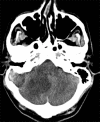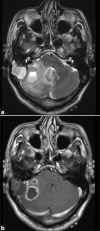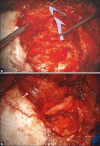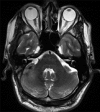Petrous bone epidermoid cyst caused by penetrating injury to the external ear: Case report and review of literature
- PMID: 22870161
- PMCID: PMC3410170
- DOI: 10.4103/1793-5482.98656
Petrous bone epidermoid cyst caused by penetrating injury to the external ear: Case report and review of literature
Abstract
Epidermoid cysts are histologically benign, slow-growing congenital neoplasms of the central nervous system that may arise from retained ectodermal implants. The epidermoid lesions are generally caused during the 3(rd) to 5(th) week of gestation by an incomplete cleavage of the neural tissue from the cutaneous ectoderm, though it can also happen later in life due to introduction of skin elements by skin puncture, trauma or surgery. We present this unique case of a petromastoid epidermoid cyst associated with ipsilateral cerebellar abscesses, presenting 20 years after a penetrating trauma to the external auditory canal. Radical excision of both lesions and revision of the previous fistulous tract was performed. We present the diagnostic challenge and the operative treatment of this unique case, which to our knowledge is the first where an epidermoid cyst and an adjacent brain abscess occurred as a result of a single traumatic event.
Keywords: Epidermoid cyst; penetrating trauma; petrous bone; surgical treatment.
Conflict of interest statement
Figures






Similar articles
-
Petrous apex epidermoid cyst: A rare case.Radiol Case Rep. 2025 Mar 15;20(6):2662-2665. doi: 10.1016/j.radcr.2025.02.047. eCollection 2025 Jun. Radiol Case Rep. 2025. PMID: 40151295 Free PMC article.
-
Intradiploic epidermoid cyst in a 15-year-old female: a rare case report.Ann Med Surg (Lond). 2024 Dec 19;87(2):915-919. doi: 10.1097/MS9.0000000000002974. eCollection 2025 Feb. Ann Med Surg (Lond). 2024. PMID: 40110295 Free PMC article.
-
Malignant transformation of intracranial epidermoid cyst.Br J Neurosurg. 2014 Aug;28(4):507-9. doi: 10.3109/02688697.2013.869552. Epub 2013 Dec 18. Br J Neurosurg. 2014. PMID: 24345076 Review.
-
Gaint epidermoid cyst of external ear- a rare case report.J Clin Diagn Res. 2014 Feb;8(2):167-8. doi: 10.7860/JCDR/2014/8099.4046. Epub 2014 Feb 3. J Clin Diagn Res. 2014. PMID: 24701521 Free PMC article.
-
Epidermoid Cyst Arising on the Body of the Tongue: Case Report and Literature Review.J Nippon Med Sch. 2018;85(6):343-346. doi: 10.1272/jnms.JNMS.2018_85-56. J Nippon Med Sch. 2018. PMID: 30568062 Review.
Cited by
-
An Asymptomatic Posttraumatic Intracranial Epidermal Inclusion Cyst: Avoiding the Maslow Hammer.Asian J Neurosurg. 2023 Sep 13;18(3):692-695. doi: 10.1055/s-0043-1774396. eCollection 2023 Sep. Asian J Neurosurg. 2023. PMID: 38152521 Free PMC article. No abstract available.
-
Petrous apex epidermoid cyst: A rare case.Radiol Case Rep. 2025 Mar 15;20(6):2662-2665. doi: 10.1016/j.radcr.2025.02.047. eCollection 2025 Jun. Radiol Case Rep. 2025. PMID: 40151295 Free PMC article.
References
-
- Hamel E, Frowein RA, Karimi-Nejad A. Intracranial intradural epidermoids and dermoids. Neurosurg Rev. 1980;3:215–9. - PubMed
-
- Revilla AG. Differential diagnosis of tumors at the cerebellopontine recess. Bull John Hopkins Hosp. 1948;83:187–212. - PubMed
-
- Ulrich J. Intracranial epidermoids: A study on their distribution and spread. J Neurosurg. 1964;21:1051–8. - PubMed
-
- Zhou LF. Intracranial epidermoid tumors: Thirty-seven years of diagnosis and treatment. Br J Neurosurg. 1990;4:211–6. - PubMed
-
- Rubin G, Scienza R, Pasqualin A, Rosta L, Da Pian R. Craniocerebral epidermoids and dermoids. Acta Neurochir (Wien) 1989;97:1–16. - PubMed
Publication types
LinkOut - more resources
Full Text Sources
Miscellaneous

